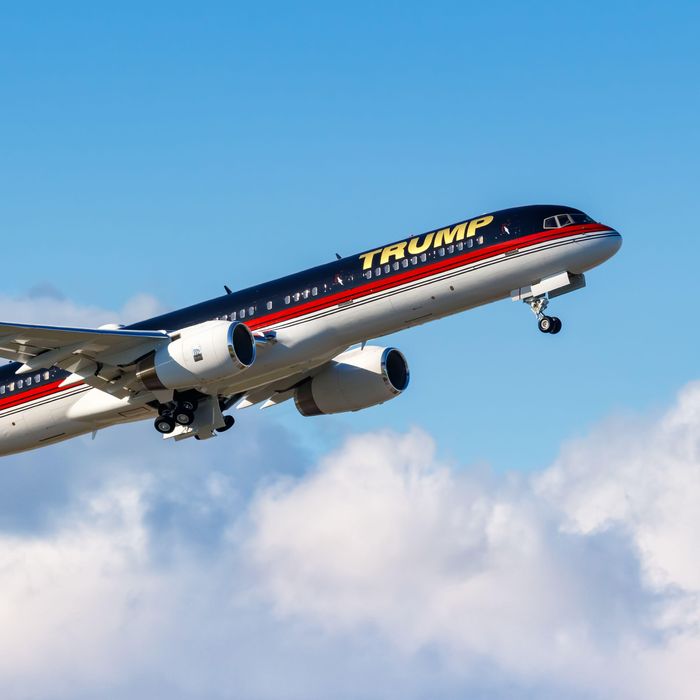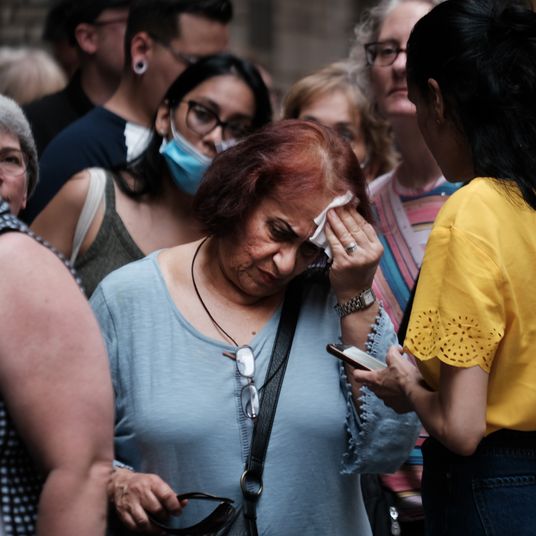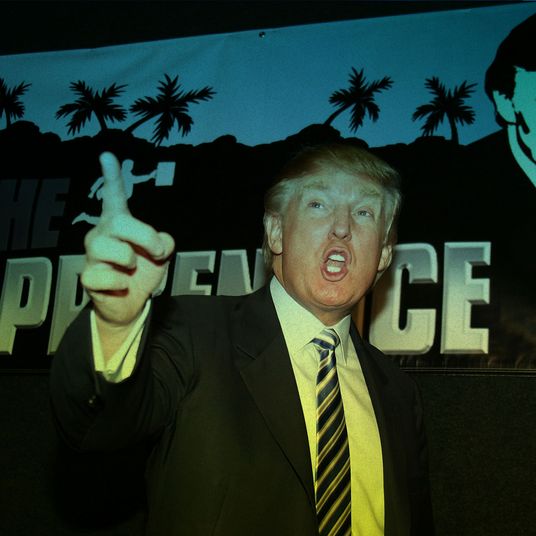
If Donald Trump gets reelected in November, he’ll win a bonanza of benefits, including freedom from prison, the ability to jail Joe Biden, a $400,000 salary, and kinglike powers. He’ll also get a massive upgrade in the quality of his air travel, from his ’90s vintage 757 dubbed Trump Force One to the real Air Force One, a pair of heavily modified 747s worth billions.
To hear Trump tell it, that’s not much of an upgrade at all. He once told Rolling Stone that Air Force One is “a step down” from his 757 “in every way.”
But that’s pure delusion. Sure, Trump’s plane is big, and it has a shiny new paint job, but from a true private-jet aficionado’s point of view, those are about its only virtues. “It’s like if you wanted to brag about having a massive yacht, so you bought the Staten Island Ferry and converted it,” says a private-jet broker who prefers not to be identified. “That’s not something that people who really know yachts would find impressive.”
Trump Force One, you might say, is a poor man’s idea of a rich man’s plane — a big shiny bauble that behind the scenes is “a plane past its prime with decaying mechanics and exorbitant storage fees,” as CNN put it. Which raises the question: Why is a guy supposedly as rich as Trump is flying around in such a jalopy? According to Bloomberg, he’s worth $6.5 billion. People with this kind of wealth generally fly planes like the Gulfstream G650 or the Dassault Falcon 8X, the Porsches and Lamborghinis of the air. By comparison, Trump is flying a secondhand school bus.
It’s not really that complicated, though. To understand the crappiness of Trump’s plane, it helps to know a bit more about planes and Trump.
The former and maybe next president’s predilection for slapping his name on superannuated aircraft goes way back. In 1988, he paid $365 million for Eastern Air Shuttle, a division of Eastern Airlines that ran short hops between New York, Boston, and Washington, D.C., on a fleet of 17 obsolescent Boeing 727s. Renaming the operation Trump Shuttle, he tried to turn the bargain carrier into a luxury brand, with maple-veneer interiors and free in-flight telephone calls, but the venture defaulted on its debts in 1992 and was repossessed by the banks.
Five years later, Trump repurchased one of the 727s for his own personal use and had the interior redecorated in mahogany and silk. It was aboard this plane that his future wife Melania Knauss was photographed lounging in the nude for GQ. Trump kept the plane until 2010, when the earnings he received from The Apprentice allowed him to acquire a much larger plane, a Boeing 757.
While a video on Trump’s website called the plane a “luxurious new 757,” it was already decades old when Trump bought it, having first flown in 1991, the year “Marky” Mark Wahlberg released “Good Vibrations.” Already out of production for years by the time Trump bought his, the 757 is an aircraft of a different era. Unlike modern planes, which use computers to control flight surfaces on the wings and tail, the 757 used cables and pushrods.
During the first part of its life, N757AF (as it’s known by its tail number) was a workhorse flying for a couple of small discount airlines — Sterling Airlines in Denmark and TAESA Airlines in Mexico — that have since gone out of business. The plane was eventually bought by Microsoft billionaire Paul Allen, who turned around and sold it to Trump. If he really did pay $100 million for the plane, as has been widely reported, he overpaid for it even more than he did for the Plaza Hotel. When it was new, Trump’s plane would have cost around $50 million, or $115 million in today’s dollars. But like most vehicles, a plane steadily decreases in value. Based on current used-aircraft listings, a 757-200 of Trump Force One vintage is today worth about $5 to $8 million.
After the purchase, Trump hired Long Island’s International Jet Interiors to reupholster the chairs and couches and add mahogany trim and suede paneling. The $250,000 project took six months and involved liberal use of the Trump family crest (which was allegedly plagiarized from Joseph Edward Davies, husband of Marjorie Merriweather Post, the original owner of Mar-a-Lago).
Back in the day, Trump’s jet hosted such luminaries as Gary Busey and Dennis Rodman. But after Trump entered the White House in 2017 and started flying Air Force One, N757AF was sidelined and wound up sitting at an airport in the Hudson Valley with one engine missing and the other wrapped in plastic. “The choice to leave it outside at a northeastern airport, exposed to the elements, has baffled aviation experts,” CNN reported at the time. “They note that it’s just a few hours’ flight to warmer, more arid climes. Snow, rain, and moisture can lead to metal corrosion of the airframe and the engines — hard to detect, and, in severe cases, catastrophic.”
After Trump left office in 2021, his 757 came out of storage and was flown down to Louisiana, where it received a new exterior paint job that replaced the giant “T” on the plane’s tail with an American flag. “It has been completely modernized and renovated, and looks GREAT,” Trump wrote on Truth Social with a link to a video showing workers at LandLocked Aviation Services of Lake Charles scrubbing, masking, painting, and polishing the exterior to a dramatic orchestral score.
Although Trump makes a big deal about the plane’s interior — a TV documentary about the plane from 2013 describes it as having “enough gold that if melted down could gold-plate the outside of a Greyhound bus” — it’s been a long time since it’s had an update. “A 14-year-old interior is probably going to be showing signs of wear and tear,” says the aircraft broker. “Carpets get worn down, leather gets old, veneer gets dinged and scratched and dented.” If Trump were trying to sell it, he says, “most new owners would want to redo it. Redo the leather, redo the wood, redo the carpet. Just bring it into a more contemporary feel.”
Its age and decrepitude aren’t the only things working against Trump Force One. Commercial airliners like the 757 are impressive pieces of engineering, but they are optimized for a particular goal (flying a lot of people together economically from point A to point B) that is quite different from that of a private jet (delivering a small number of wealthy people around in a high degree of comfort). As a result, they offer a very different kind of performance. Compared to a top-end private jet like the Gulfstream G650, which cruises at Mach 0.9 at altitudes of up to 51,000 feet, the 757 flies both lower and slower, with a cruise speed of Mach 0.8 and a maximum altitude of 42,000 feet. As a result, it takes longer to get where it’s going and is more susceptible to turbulence from stormy weather. The Gulfstream can also take you farther, with a range of more than 8,000 miles compared to 4,500 miles for a 757-200 like Trump’s. That means that, while the Boeing can cross the Atlantic in a single hop, the Gulfstream can cross the Pacific.
Another problem is that Trump’s plane can’t go to many of the places rich people like: Weighing more than 100,000 pounds, it’s barred from landing at the kind of small, conveniently located airports that private jets prefer, like Aspen, Gstaad, and Teterboro. Another feature that private-jet owners care about is the “cabin altitude.” Basically, the lower the cabin altitude, the thicker the air, the easier it is to breathe, and the less likely you are to get a headache. When it’s flying at its maximum altitude, the 757 is able to pressurize its cabin to 8,000 feet, roughly what you’d experience at the base of a Colorado ski resort. When flying at 51,000 feet, the Gulfstream G650 is able to pressure its cabin to 4,850 feet, which is like being in Denver.
For a private jet, bigger can still be better if you really need a lot of space. Previous owner Allen reportedly used the jet to fly around sports teams, for instance. And Middle Eastern sheikhs are said to be fond of traveling with large entourages. For Trump, the main virtue of size is that he can use the plane as a billboard, parking it behind himself at rallies as a synecdoche for his wealth. “Buying a 25-year-old 757 is like buying a bag of Cheetos,” an aviation consultant told the New York Times in 2016. “It’s a lot of food for a low price.”
As a frequently bankrupt man whose main asset is the carefully nurtured perception that he is a skilled and successful businessman, Trump has mastered the art of flaunting his status symbols even when their shortcomings are evident. Just as he has managed to frame his bankruptcies as displays of business savvy (“We’ll have the company. We’ll throw it into a chapter. We’ll negotiate with the banks. We’ll make a fantastic deal,” he once bragged), he has framed the low-end nature of his aircraft as a reflection of his crafty deal-making. In an interview with the Times in 2016, he said that he liked older planes “because they had been ‘tested’ and had ‘been around.’”
Until recently, Trump also owned a much smaller Cessna 750 Citation X, a proper business jet, and two Sikorsky helicopters. His website describes the eight-passenger Citation as a “magnificent aircraft,” adding that “the signature Trump Crest is featured prominently on the exterior adding an even higher level of luxury and beauty to this magnificent aircraft.” In reality, the Citation X is on the small end for a private jet, and Trump’s 27-year-old aircraft was the oldest of its kind in the air. In 2016, the FAA grounded it temporarily after the Times reported that its registration expired. Last year, Trump put it up for sale. Though the plane was widely described in the media as being worth $8.5 to $10 million, Citation Xs of that vintage typically sell for a third as much, and Trump’s was finally purchased last month for just $2.5 million by an Iranian American real-estate developer who had previously given some $250,000 to a Trump-allied political committee. Trump’s helicopters are also long in the tooth. His two Sikorsky S-76B helicopters, built in 1989 and 1992, would be worth about $7.5 million new but are valued at about $800,000 now.
Of course, however dilapidated Trump’s fleet of aircraft may be, the mere fact that he owns private jets and helicopters is a clear sign that he remains wealthy. But if he fails to retake the White House, all that could be in jeopardy. He has hundreds of millions of dollars in legal judgments he must pay for fraud and defamation. Depending on how Trump’s various legal and political battles play out, it’s easy to imagine his finances imploding in a way he’s never yet experienced. And if his assets wind up getting repossessed, his aircraft will probably be among the first to go.
































